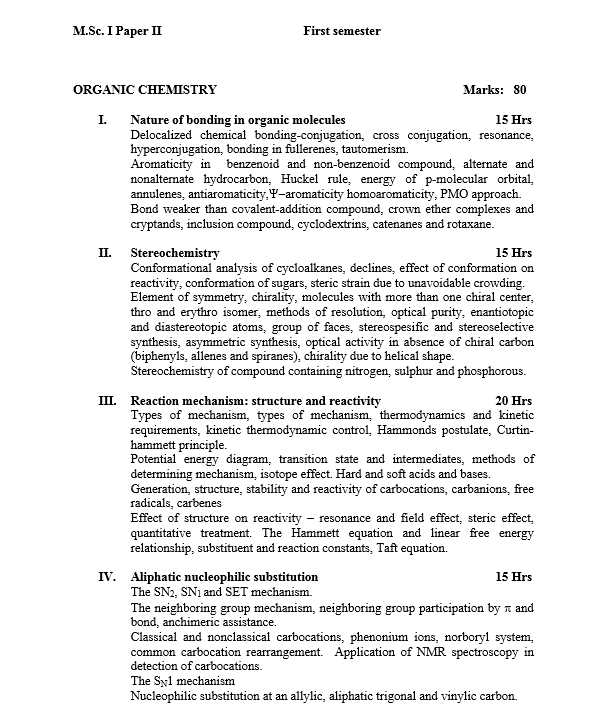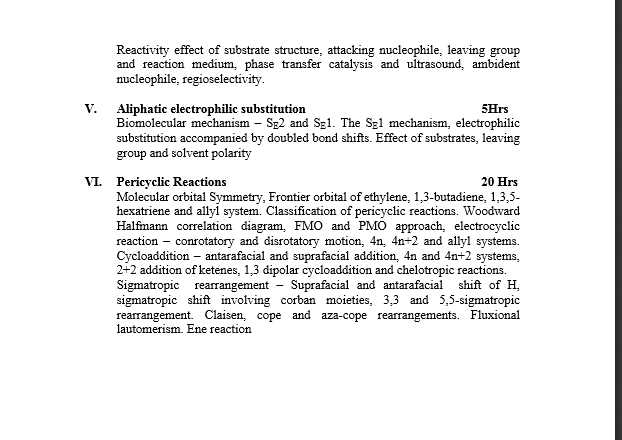| 19th October 2016 06:14 PM | |
| shikha | Re: Syllabus of Chemistry of Lucknow University As you want I am here giving you syllabus for Organic Chemistry Subject of MSC Chemistry course of Lucknow University. Syllabus for Organic Chemistry Subject of MSC Chemistry course: Nature of bonding in organic molecules Delocalized chemical bonding-conjugation, cross conjugation, resonance, hyperconjugation, bonding in fullerenes, tautomerism. Aromaticity in benzenoid and non-benzenoid compound, alternate and nonalternate hydrocarbon, Huckel rule, energy of p-molecular orbital, annulenes, antiaromaticity,Ψ−aromaticity homoaromaticity, PMO approach. Bond weaker than covalent-addition compound, crown ether complexes and cryptands, inclusion compound, cyclodextrins, catenanes and rotaxane. II. Stereochemistry Conformational analysis of cycloalkanes, declines, effect of conformation on reactivity, conformation of sugars, steric strain due to unavoidable crowding. Element of symmetry, chirality, molecules with more than one chiral center, thro and erythro isomer, methods of resolution, optical purity, enantiotopic and diastereotopic atoms, group of faces, stereospesific and stereoselective synthesis, asymmetric synthesis, optical activity in absence of chiral carbon (biphenyls, allenes and spiranes), chirality due to helical shape. Stereochemistry of compound containing nitrogen, sulphur and phosphorous. III. Reaction mechanism: structure and reactivity Types of mechanism, types of mechanism, thermodynamics and kinetic requirements, kinetic thermodynamic control, Hammonds postulate, Curtin-hammett principle. Potential energy diagram, transition state and intermediates, methods of determining mechanism, isotope effect. Hard and soft acids and bases. Generation, structure, stability and reactivity of carbocations, carbanions, free radicals, carbenes Effect of structure on reactivity – resonance and field effect, steric effect, quantitative treatment. The Hammett equation and linear free energy relationship, substituent and reaction constants, Taft equation. IV. Aliphatic nucleophilic substitution The SN2, SN1 and SET mechanism. The neighboring group mechanism, neighboring group participation by π and bond, anchimeric assistance. Classical and nonclassical carbocations, phenonium ions, norboryl system, common carbocation rearrangement. Application of NMR spectroscopy in detection of carbocations. The SN1 mechanism Nucleophilic substitution at an allylic, aliphatic trigonal and vinylic carbon. Reactivity effect of substrate structure, attacking nucleophile, leaving group and reaction medium, phase transfer catalysis and ultrasound, ambident nucleophile, regioselectivity. Syllabus for Organic Chemistry Subject of MSC Chemistry course   Contact : University of Lucknow Lucknow University Main Building, University Road, Babuganj, Hasanganj, Lucknow, Uttar Pradesh 226007 088086 66125 |
| 19th October 2016 04:43 PM | |
| Unregistered | Syllabus of Chemistry of Lucknow University Will you please give here syllabus for Organic Chemistry Subject of MSC Chemistry course of Lucknow University ? |